Not so Common Pitched Roofs
 Our independent surveyors can offer a range of survey reports; from Building Surveys (also known as Structural Surveys), to Home Buyers Reports, to Specific Defects Reports for issues such as roof problems, dampness issues, subsidence, and much more.
Our independent surveyors can offer a range of survey reports; from Building Surveys (also known as Structural Surveys), to Home Buyers Reports, to Specific Defects Reports for issues such as roof problems, dampness issues, subsidence, and much more.
If you have a property problem we may even have written an article on it and we would refer you to the many articles we have on our free building articles page Click Here.
Please free phone us on 0800 298 5424 and a surveyor will call you back.
Types of roof problems
Roof problems fall into two categories: repairable and replacement needed and roofs themselves fall into two categories: pitched and flat (please also see our articles on common pitched roofs and flat roofs).
Free phone 0800 298 5424
Pantile roof
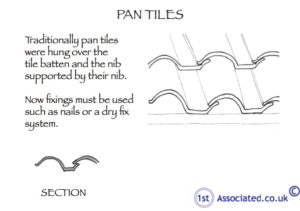 This depends upon the year it was built; post war with a felt and pre-war without felt, although we have seen older examples of roofs with the felt adding and we assume this was carried out at a later date or the builder's general standards meant that he wanted to add a sarking felt.
This depends upon the year it was built; post war with a felt and pre-war without felt, although we have seen older examples of roofs with the felt adding and we assume this was carried out at a later date or the builder's general standards meant that he wanted to add a sarking felt.
The problems with this type of finish is that the tiles can be lifted and displaced quite easily and then the only protection is the protective underlayer, assuming it has one, which is not ideal.
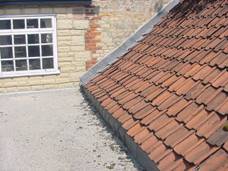 |
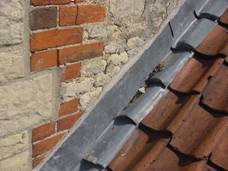 |
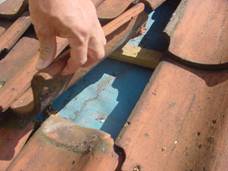 |
|
General view of a pantile roof
|
Close up of the flashing
|
Close up underneath the pantile
|
Other roofs
An asbestos based roof
Please see our articles on asbestos:
Asbestos
Industrial Commercial Properties - The Asbestos Cement Dilema
Dealing with Asbestos in a Retail Unit
Thatched roof
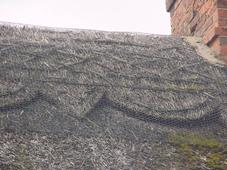 Thatch was the most common form of roofing in Britain until about the 17th Century on domestic structures, particularly in the South East of England. Its use was limited by legislation due to the risk of fire, initially in the City of London , (unfortunately after the Fire of London!) which in turn, was followed by larger cities/towns, and eventually considered good building practice nationwide.
Thatch was the most common form of roofing in Britain until about the 17th Century on domestic structures, particularly in the South East of England. Its use was limited by legislation due to the risk of fire, initially in the City of London , (unfortunately after the Fire of London!) which in turn, was followed by larger cities/towns, and eventually considered good building practice nationwide.
For example, in London , it was compulsory by 1212 to give thatch a coat of white wash to protect it from sparks, and new houses were not allowed to be thatched from this date. However, this legislation took some time to be adopted in other areas, but by the early/mid 18th Century, thatch was generally prohibited from use.
Types of Thatch
There are three main types of thatch common in England ; Long straw, Water Reed (originally called Norfolk reed) and Combed wheat reed all usually laid on a pitch of about 55°.
Combed Wheat Reed (originally known as Devon Reed)
Wheat reed will tend to have a bristled finish and will typically have a life of 20 to 40 years from new. However, it will require maintenance throughout its life.
Long Straw
Long straw is typified by its "shaggy" soft look and it is typically considered to have a life of between 10 and 20 years from new. However, it will require some maintenance throughout this period
Water Reed (originally known as Norfolk reed)
Norfolk reed is typified by its solid, neat, clean cut appearance. It is typically considered to have a life of between 50 and 70 years from new. However, it will require some maintenance throughout this period.
Plastic (Polycarbonate) roofs
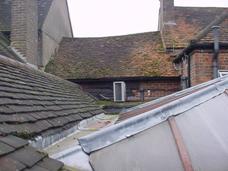 |
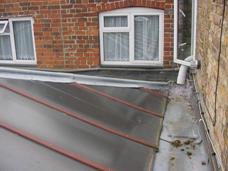 |
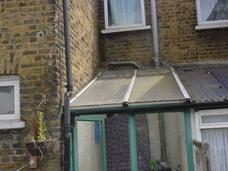 |
|
Conservatory extension adjoining original property with a plastic / polycarbonate roof
|
Awkward valley gutter detailing
|
Two types of plastic roofing over rear accesses
|
Glass roofs
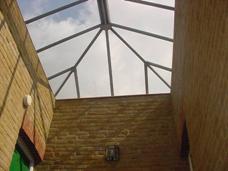 |
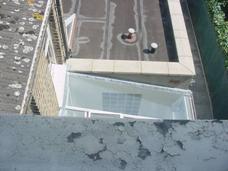 |
|
Glass atrium roof |
Hidden glass roof |
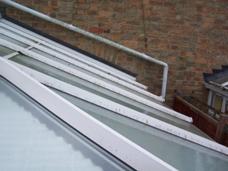 |
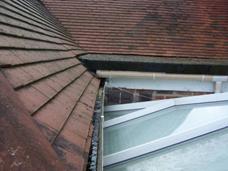 |
|
Close up of a glass roof within a plastic coated metal frame
|
Awkward detailing
|
Stone roofs
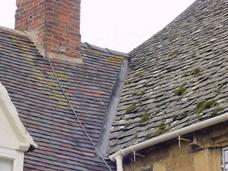 |
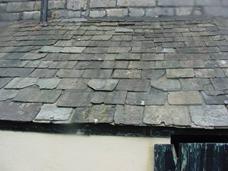 |
|
Stone roof (on right hand side)
|
Stone roof in state of disrepair
|
How do I repair my roof?
How do I find a good roofer?
This probably has to be equivalent to the how long is a piece of string question. First we would say you need to ensure that whoever you use has your best interest at heart rather than their best interest and that they are not simply trying to sell you the most profitable solution to them. Word of mouth is a great way of finding good builders but do be aware that often word of mouth recommendations come via someone who doesn't have any experience or expertise or working with builders.
Therefore the reasons for their word of mouth could be that the builder turned up on the day that he said he would, finished the job on the day that he said he would and charged the price he said he would, which ironically can be a good recommendation, but not if the work carried out was technically wrong or of poor quality. You should also take great care if your property is an old property as it could be a Listed Building or in a conservation area or simply need a builder that knows how to deal with older properties.
Equally, a newer property also has to be dealt with in an appropriate manner, so the experience the builder has is very important. We have developed a specific defects report for looking at a specific problem, such as chimneys on your property. These originally developed from our engineers report that specifically looked at structural cracks in properties, which then moved onto us giving specific advice on dampness in properties, due to many contractors being involved in this industry simply being there to sell a product rather than to give you best advice.
If you truly do want an independent expert opinion from a surveyor with regard to chimneys, roof problems, roof repairs, roof materials or any other matters please contact 0800 298 5424 for a surveyor to give you a call back.
Access requirements
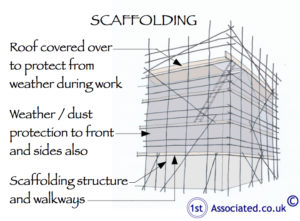 It is very, very likely that on a re-roof or a major repair scaffolding will be required. Scaffolding is not cheap and you will also have to make the decision as to whether a roof is put over the top of the scaffolding in case it rains or there is inclement weather during the course of the repair or renewal work to the roof.
It is very, very likely that on a re-roof or a major repair scaffolding will be required. Scaffolding is not cheap and you will also have to make the decision as to whether a roof is put over the top of the scaffolding in case it rains or there is inclement weather during the course of the repair or renewal work to the roof.
Please see our article on scaffolding.
Work carried off long ladders and crawler boards

In years gone by most roofing work would be carried out off long ladders and crawler boards. This simply wasn't safe then and is certainly not safe now. A good contractor will insist upon a scaffolding to work from, even where the site is difficult, for example where there is a shop front that you have to work around, there are scaffolding solutions. In that instance using a unitary scaffold. Some people use unitary scaffolds all the time as it saves them time, but we certainly would not recommend crawler boards and a ladder.
If you would like help and advise with regard to roofs, roof problems, roof repairs, roof materials or any other matters please call 0800 298 5424 for a friendly chat. Please note we are independent surveyors.
If you have a commercial property and require dilapidations help then please visit our www.DilapsHelp.com website and for Disputes go to our Disputes Help site www.DisputesHelp.com .
We hope you found the article of use and if you have any experiences that you feel should be added to this article that would benefit others, or you feel that some of the information that we have put is wrong then please do not hesitate to contact us (we are only human).
The contents of the website are for general information only and is not intended to be relied upon for specific or general decisions. Appropriate independent professional advice should be paid for before making such a decision
All rights are reserved the contents of the website are not to be reproduced or transmitted in any form in whole or part without the express written permission of 1stAssociated.co.uk.
